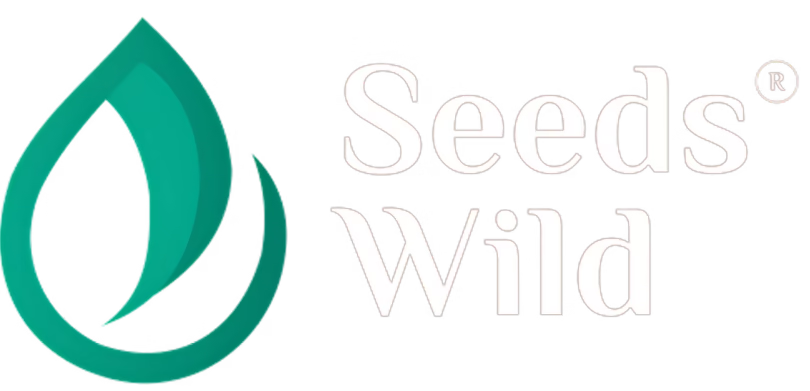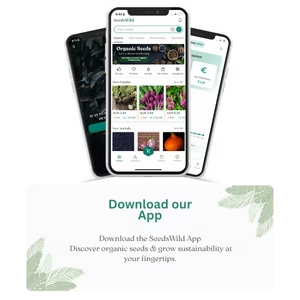A flash of electric blue, a hint of cucumber on the tongue, and an oil famed for skin health—borage (Borago officinalis) ticks every box. Here’s how this Mediterranean native became a must-have from seed tray to kitchen.
1. Where Does Borage Come From?
- Native range: Mediterranean basin (Syria, Türkiye, Spain); now naturalised throughout Europe, North America, and temperate Asia.
- Family: Boraginaceae (kin to forget-me-not and comfrey).
- Life cycle: Hardy annual that self-seeds so reliably it behaves like a short-lived perennial.
- Signature look: Soft, oval, downy leaves and deep-blue (occasionally white or pink) star-shaped flowers.
🧠 Seedswild Sow_stage: The app flags the perfect sowing window (soil ≥ 10 °C and frost risk clear) for your exact location.
2. A Plant of Many Talents
| Field | Key Components | Practical Gains |
|---|---|---|
| Nutrition | Leaves rich in potassium, calcium, vitamin C; flowers packed with antioxidants | Young leaves in salads; edible blossoms for cocktails, desserts |
| Health | Seed oil: 17–24 % GLA (gamma-linolenic acid) | Supports skin elasticity, soothes eczema and dryness (inside & out) |
| Ecology | Among the highest nectar yields of any annual | Magnet for bees and bumble-bees from May onward; boosts veg-patch pollination |
| Companion planting | Tap-root loosens soil; foliage mildly pest-repellent | Ideal near strawberries, tomatoes, courgettes (pollinator draw, fewer aphids) |
3. Growing Borage Step by Step
3.1 Sowing
| Timing | Method |
|---|---|
| March–April (or Sept.–Oct. in mild regions) | Direct-sow: 1 cm deep, 25 cm apart |
Even spread tip: Mix the black seeds with dry sand for better distribution.
3.2 Low-Maintenance Care
| Task | Frequency | Why? |
|---|---|---|
| Watering | Light for first two weeks; then only in drought | Deep tap-root = good self-sufficiency |
| Mulching | Right after emergence | Retains moisture, suppresses weeds |
| Staking | Optional (flexible stems) | Useful in windy spots to prevent breakage |
| Feeding | None | Rich soil → too many leaves, fewer flowers |
🚨 Weather Alerts: The app warns of gusts > 60 km/h or extreme heat—mulch or provide shade as needed.
3.3 Harvest
- Leaves: Pick young, pre-flower, for the finest flavour.
- Flowers: Take as they open; freeze in ice cubes for decorative drinks.
- Seeds: Late summer, when husks turn brown; press for oil or re-sow.
4. Wellness Note—Use with Care
- Extended internal use: Choose borage oil certified low in pyrrolizidine alkaloids (PA) and follow label dosage.
- Pregnancy / breastfeeding: Seek medical advice before supplementing.
- Wild gathering: Avoid confusion with toxic look-alikes (e.g., foxglove, deadly nightshade); fresh cucumber scent is a reliable clue.
5. Why Borage Belongs in Your Seedswild Ecosystem
- Colour & flavour: Vivid blue petals and a fresh twist lift any dish.
- Skin health: One of the richest plant sources of GLA.
- Pollinator magnet: A “nectar station” for bees and helpful insects.
- Ease: Self-sows, grows anywhere, needs zero fertiliser.
- Circular economy: Seed saving = autonomy + minimal carbon footprint.
Ready to add borage? Head to Seedswild Marketplace for organic seed and let our AI modules guide you—from sowing to starlike bloom. Your garden, your taste buds, and the pollinators will be grateful! 🌱✨
Bonus ✨: Borage Infusion for Coughs & Colds
Ingredients:
- 1 handful of fresh borage flowers
- 1 large mug of water
Method: Bring the water just to a simmer (not a full boil). Add the borage flowers and steep for about 5 minutes. Strain and drink. For maximum benefit, aim to drink up to one litre of the infusion spread throughout the day.
Borage is edible too: Its flowers and tender leaves can be eaten fresh in salads like other aromatic herbs. The leaves have a cucumber-like flavor, while the flowers hint at the taste of oyster.
Why It Helps
- Soothing action: Borage is rich in mucilage, which coats and calms irritated mucous membranes.
- Mild diuretic: Its potassium-nitrate content supports gentle detoxification.
- Sweat-inducing: Flowers and leaves encourage perspiration, helping the body fight coughs, colds, and bronchitis.
The seeds are also high in gamma-linolenic acid (omega-6); when pressed, they yield an oil valued in skincare for its anti-ageing properties.
Conclusion
Borage is the Mediterranean superstar for both your garden and your health. With its vivid blooms and multitude of uses, it’s easy to see why it should be a staple in any garden. Whether you use it for skin health, as a pollinator magnet, or in culinary creations, borage has earned its place as a must-grow herb. 🌱✨

